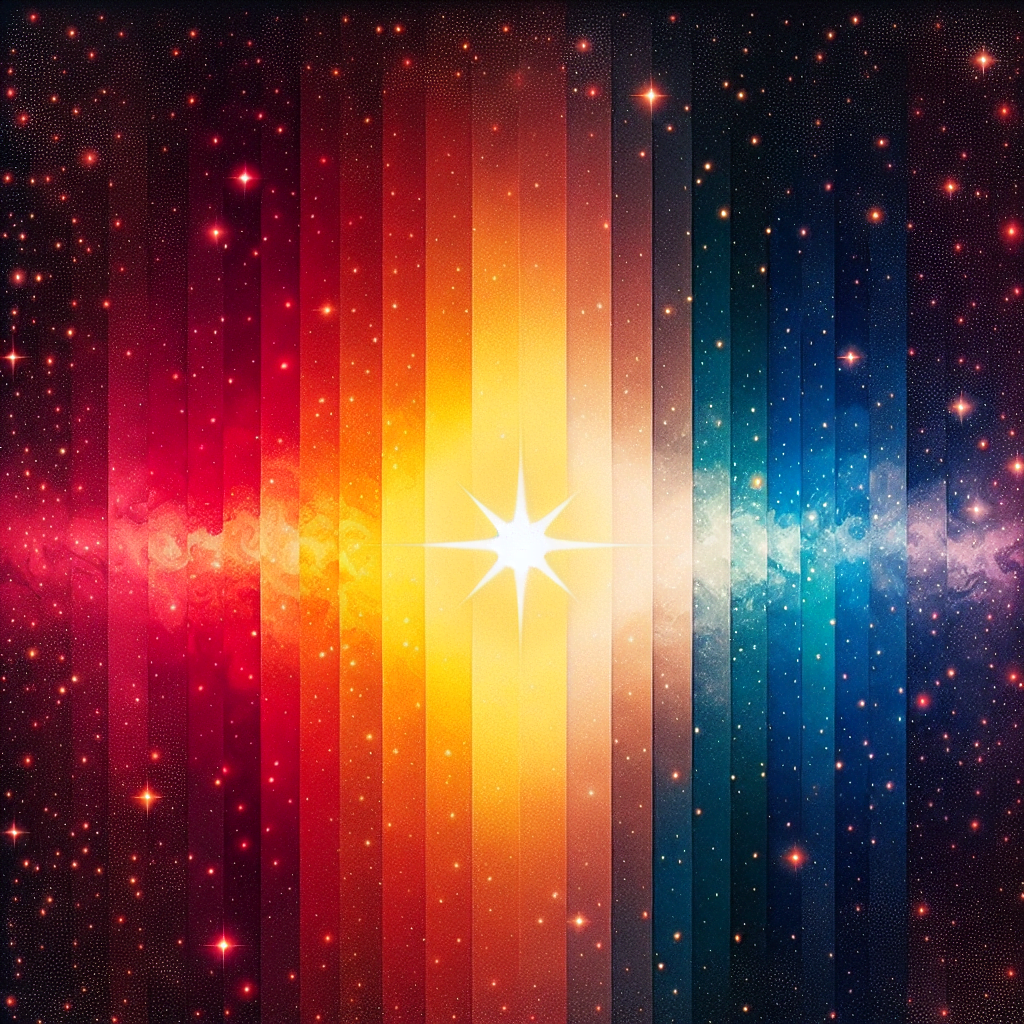Have you ever wondered how astronomers can determine the temperature of stars just by looking at their colors? It may seem like magic, but in reality, it’s all about understanding the science behind light and electromagnetic radiation. By examining the different wavelengths of light emitted by stars, scientists are able to decode the secrets hidden within their vibrant hues. In this article, we will explore the fascinating connection between star colors and temperature, unraveling the mysteries of the universe one vibrant hue at a time.

Table of Contents
Understanding Star Colors
Why do stars appear different colors?
Stars appear different colors because of their surface temperature. The color of a star is determined by the elements present in its atmosphere and the temperature at which those elements emit light. The hotter a star’s surface temperature, the bluer it appears, while cooler stars appear more red.
What causes the color of a star to change?
The color of a star can change due to various factors. One factor is the age of the star, as stars undergo changes throughout their lifetime. Additionally, changes in a star’s atmosphere, such as the presence of different elements or fluctuations in their concentrations, can also affect its color. The interaction between a star and its surrounding environment, such as the presence of interstellar dust or gas, can also alter its perceived color.
How is the temperature of a star related to its color?
The temperature of a star is directly related to its color. This relationship is known as the color-temperature relationship. Hotter stars emit more energy and appear bluer, while cooler stars emit less energy and appear redder. This relationship holds true for most stars, allowing astronomers to estimate a star’s temperature based on its observed color.
The role of a star’s surface temperature
The surface temperature of a star plays a crucial role in multiple aspects of its existence. It determines the color of the star, as mentioned earlier, but it also influences its luminosity, lifespan, and overall behavior. By understanding a star’s surface temperature, astronomers gain valuable insights into its physical characteristics and evolutionary stage.
The Color-Temperature Relationship
What is color temperature?
Color temperature refers to a numerical value assigned to a light source, such as a star, to describe the color of the light it emits. It is measured in Kelvins (K). The concept of color temperature is based on the idea that when an object is heated, it emits light at different colors, with hotter objects producing bluer light and cooler objects producing redder light.
How is color temperature measured?
Color temperature is measured using specialized instruments called spectrophotometers. These instruments analyze the spectrum of light emitted by a star, breaking it down into its constituent colors. By studying the distribution of colors in the spectrum, astronomers can determine the star’s color temperature.
The color-temperature scale
The color-temperature scale categorizes stars based on their observed color, from the hottest to the coolest. This scale ranges from blue to white, yellow, orange, and finally red. The colors correspond to different temperature ranges, with blue stars being the hottest and red stars being the coolest.
The relationship between color and temperature
The relationship between color and temperature follows a predictable pattern. As mentioned earlier, hotter stars emit bluer light, while cooler stars emit redder light. This relationship arises from the physics of blackbody radiation, where the temperature of an object determines the peak wavelength of light it emits. Thus, by observing the color of a star, astronomers can infer its approximate temperature.
Spectral Classification of Stars
What is spectral classification?
Spectral classification is a method used by astronomers to categorize stars based on the characteristics of their spectra. A star’s spectrum is obtained by dispersing its light using a prism or diffraction grating, revealing a unique pattern of absorption and emission lines. Spectral classification allows astronomers to classify stars into different categories based on their spectral features.
What are stellar spectrums?
A star’s spectrum is a graphic representation of the distribution of light emitted by a star at different wavelengths. It shows the unique pattern of dark or bright lines formed when certain elements in the star’s atmosphere absorb or emit light. By analyzing these spectral lines, astronomers can determine the chemical composition and temperature of a star, providing valuable information about its properties.
The OBAFGKM classification
The OBAFGKM classification is the most commonly used system for spectral classification of stars. It categorizes stars into seven main types based on their spectral features, with O-type stars being the hottest and M-type stars being the coolest. Each spectral type is further divided into subclasses, resulting in a detailed classification scheme to describe stars of various temperatures.
How does spectral class relate to surface temperature?
The spectral class of a star is directly related to its surface temperature. Hotter stars have stronger and broader absorption lines in their spectrum, indicating a higher temperature, while cooler stars have narrower and weaker lines. The spectral classification system provides a convenient way for astronomers to determine the temperature of stars based on their observed spectral features.
Blue and White Stars
Why are blue and white stars hotter?
Blue and white stars are hotter than other stars because their surface temperatures are higher. The bluish-white color of these stars is indicative of their high temperature, which can range from tens of thousands to hundreds of thousands of degrees Celsius. The intense heat of these stars results in the emission of predominantly blue light.
How is the surface temperature of blue and white stars determined?
The surface temperature of blue and white stars can be determined through spectroscopy. By analyzing the absorption and emission lines in the star’s spectrum, astronomers can estimate its temperature. The broad and strong absorption lines in the spectra of blue and white stars indicate high temperatures.
Special characteristics of blue and white stars
Blue and white stars have unique characteristics beyond their high temperature. They are often massive, with a higher mass and luminosity compared to other stars. These stars also tend to have shorter lifespans and can be the source of intense radiation and stellar winds. Blue and white stars are frequently found in young star clusters, where massive stars are formed.

Yellow and Orange Stars
Why are yellow and orange stars cooler?
Yellow and orange stars appear cooler because their surface temperatures are lower compared to blue and white stars. The yellow or orange color indicates a temperature range between a few thousand to around 6,000 degrees Celsius. These stars emit light predominantly in the visible spectrum, with a smaller proportion in the ultraviolet and infrared ranges.
Characteristics of yellow and orange stars
Yellow and orange stars possess distinct characteristics. They often have lower mass and luminosity compared to blue and white stars. Yellow stars, such as our Sun, are often referred to as main-sequence stars in the later stages of their lives. These stars can have longer lifespans compared to more massive stars and are commonly found in mature star systems.
The surface temperature of yellow and orange stars
The surface temperature of yellow and orange stars is estimated through spectroscopic analysis. By examining the absorption lines in their spectra, astronomers can determine the temperature range of these stars. The narrower and weaker lines observed in the spectrum indicate lower temperatures compared to blue and white stars.
Red and Brown Stars
The coolest stars in the universe
Red and brown stars are the coolest stars in the universe. They have the lowest surface temperatures, ranging from a few thousand degrees Celsius down to just a few hundred degrees. The deep red or brown color of these stars is a result of their low temperature and the dominance of infrared light in their emitted radiation.
What causes the red or brown color?
The red or brown color of these stars is caused by their low temperature and the lack of significant emission in the visible light spectrum. Instead, they emit a significant amount of energy in the infrared range, which is invisible to the human eye. This dominance of infrared light contributes to their distinct reddish or brownish appearance.
How can the temperature of red and brown stars be determined?
Determining the temperature of red and brown stars is challenging because they emit little visible light. However, by observing the distribution of energy across different wavelengths, astronomers can estimate their temperature. The peak wavelength at which these stars emit the most energy provides valuable information about their surface temperature.
Unique features of red and brown stars
Red and brown stars have unique features that set them apart from other stars. They are often dimmer and less massive compared to blue and white stars. Some of these stars, known as red dwarfs, are the most common type of star in the galaxy. Red and brown stars also have the potential to host potentially habitable planets, as their low temperature allows for the existence of liquid water in certain conditions.

The Effect of Stellar Evolution
How does stellar evolution affect star color?
Stellar evolution, the process by which stars change over time, has a significant impact on their color. As a star evolves, its temperature, luminosity, and chemical composition change, leading to shifts in its color. For example, a star may start as a hot, blue star and evolve into a cooler, redder star during the later stages of its life.
The life cycle of a star
The life cycle of a star begins with the gravitational collapse of a molecular cloud, leading to the formation of a protostar. The protostar then undergoes fusion reactions in its core, becoming a main-sequence star. Depending on its mass, a star may go through various stages, such as expansion into a red giant, shedding its outer layers as a planetary nebula, and eventually becoming a white dwarf, neutron star, or black hole.
Color changes throughout a star’s life
Throughout a star’s life, its color can undergo significant changes. As a star evolves, its surface temperature and chemical composition change, altering the distribution of energy it emits. A star may transition from appearing blue in its early stages to becoming yellow or orange as it ages. In the final stages, a star may turn red or brown before fading away as a stellar remnant.
Stellar remnants and their colors
Stellar remnants, such as white dwarfs, neutron stars, and black holes, also exhibit unique colors. White dwarfs are often white or bluish in color, as they are hot and emit a substantial amount of ultraviolet radiation. Neutron stars, on the other hand, are incredibly dense and can emit X-ray radiation. Black holes, while not directly observable, have an event horizon that emits radiation, including X-rays.
Observing and Measuring Star Colors
Methods of star color observation
Observing the color of stars can be done through various methods. Astronomers often rely on telescopes equipped with color cameras or specialized filters to capture the light emitted by stars. Spectroscopy is another essential method, where the spectrum of a star is analyzed to determine its color and temperature.
The use of color filters and cameras
Color filters and cameras are commonly used tools for studying star colors. These filters allow astronomers to isolate specific wavelengths of light, providing valuable information about a star’s color temperature. Color cameras, on the other hand, capture the overall color of the star as it is perceived by the human eye.
Specialized telescopes for studying star colors
Some telescopes are specifically designed for studying star colors. These telescopes may be equipped with advanced spectrographs and imaging systems to capture detailed information about a star’s color spectrum. These specialized telescopes allow astronomers to obtain precise measurements of a star’s color and make more accurate temperature estimations.
Quantifying star color using photometry
Photometry is a technique used to quantify the color of stars. It involves measuring the brightness of a star in different wavelength bands, allowing astronomers to determine its color index. The color index provides a numerical value that indicates the star’s color and can be used to estimate its temperature. Photometry is a fundamental tool in analyzing star colors.

Applications of Star Color-Temperature Relationship
Using star color to estimate temperature
The relationship between star color and temperature has various practical applications. Astronomers can use the observed color of a star to estimate its temperature, which provides essential insights into its physical properties. This information is crucial for understanding stellar evolution, the formation of planetary systems, and the overall dynamics of galaxies and star clusters.
Applications in astronomy and astrophysics
The color-temperature relationship is a cornerstone of astronomy and astrophysics. It allows astronomers to classify stars based on their spectral features, which, in turn, provides valuable information about their temperatures, luminosities, and evolutionary stages. This knowledge is critical in studying stellar populations, understanding the interstellar medium, and exploring the nature of the universe.
Studying star clusters and galaxies
The color-temperature relationship plays a vital role in studying star clusters and galaxies. By analyzing the colors of stars within these celestial structures, astronomers can gain insights into the age and composition of the stellar populations. The color-temperature relationship helps identify different types of stars within a cluster or galaxy, allowing for a deeper understanding of its formation and evolution.
Discovering exoplanets
The color-temperature relationship can be applied to the study of exoplanets. By characterizing the star, including its color and temperature, astronomers can gather information about the host star’s habitable zone and better understand the potential conditions for supporting life on any orbiting exoplanets. The relationship between star color and temperature aids in the search for habitable environments beyond our solar system.
Conclusion
In conclusion, understanding the relationship between star color and temperature is crucial for unraveling the mysteries of the universe. By studying the color-temperature relationship, astronomers can estimate a star’s temperature, infer its physical characteristics, and gain insights into its evolutionary stage. This knowledge has widespread applications in astronomy and astrophysics, enabling scientists to explore the dynamic nature of star clusters, galaxies, and even exoplanets. Advancements in star color research will further enhance our understanding of the cosmos and shed light on the complex processes shaping the universe.

